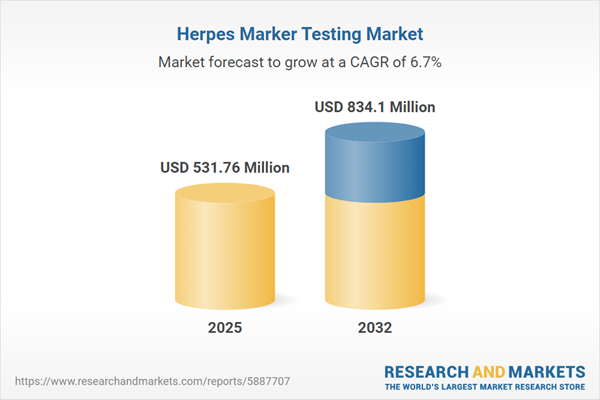Speak directly to the analyst to clarify any post sales queries you may have.
The herpes marker testing market is evolving as healthcare leaders demand greater accuracy, operational continuity, and strategic alignment in diagnostic solutions. Senior executives require clear, trusted market research to guide investment, anticipate scientific trends, and support patient-focused innovation.
Herpes Marker Testing Market Snapshot: Sizing, Growth Pace, and Industry Outlook
In 2024, the herpes marker testing market reached USD 497.86 million, with a projected compound annual growth rate (CAGR) of 6.66% through 2032, aiming for USD 834.10 million in market size. Ongoing expansion is driven by heightened awareness of herpes infections alongside strong clinical demand for reliable diagnostics. Industry participants are improving assay sensitivity, broadening test menus, and diversifying their product range to cater to healthcare providers in both clinical and laboratory settings. Continued investments in innovation and workflow optimization position the sector to address shifting healthcare needs and sustain adaptability on a global scale.
Scope & Segmentation: Herpes Marker Testing Market
Strategic segmentation enables executive stakeholders to align resources with market needs, ensuring resilient strategies and timely adaptation. Comprehensive insight into segment dynamics empowers targeted portfolio management and effective go-to-market planning within the herpes marker testing sector.
- Test Types: Combined antibody assays analyze both HSV-1 and HSV-2 in a single process for comprehensive clinical review, while single-analyte assays enable precise identification of oral or genital manifestations and inform tailored interventions.
- Technologies: Enzyme-linked immunosorbent assays (ELISA) ensure consistent laboratory-based diagnostics. Polymerase chain reaction (PCR) methods deliver greater sensitivity in molecular testing. Rapid formats, including lateral flow and latex agglutination, offer fast results in point-of-care and emergency contexts, and Western blot provides a confirmatory path for challenging cases.
- End Users: General clinical practices, specialty clinics, hospitals, reference laboratories, and research institutes represent distinct environments, each requiring alignment between test offerings and patient caseload complexity, influencing adoption patterns and procurement.
- Distribution Channels: Institutional tenders, direct sales channels, hospital group purchasing, retail pharmacy outlets, and growing e-commerce presence enhance accessibility and compliance, adapting to procurement processes and localized market expectations.
- Regional Scope: The Americas and Europe, with advanced diagnostic infrastructure, drive sustained demand, while Asia-Pacific, the Middle East, and Africa register robust growth as laboratories modernize and local investment patterns shift. Regional reimbursement and regulatory frameworks shape both market penetration and commercial strategy.
- Leading Industry Players: F. Hoffmann-La Roche AG, Abbott Laboratories, Thermo Fisher Scientific Inc., Siemens Healthineers AG, Danaher Corporation, bioMérieux SA, Qiagen NV, Becton Dickinson and Company, DiaSorin S.p.A., and Bio-Rad Laboratories, Inc. support international advances through technology leadership and strategic collaboration.
Key Strategic Takeaways for Senior Decision-Makers
- Integrate an array of molecular and rapid testing platforms to deliver robust diagnostic performance in both centralized laboratories and near-patient or decentralized care environments.
- Strengthen and diversify supply chains to minimize potential logistics disruptions and uphold uninterrupted laboratory operations across regions.
- Foster partnerships between diagnostic technology providers, biotechnology firms, and academic or clinical networks to accelerate the pace of new assay development and respond to clinical needs.
- Leverage digital automation and artificial intelligence to achieve workflow standardization, enhanced data interpretation, and dependable clinical decision support in laboratory settings.
- Align and adapt test portfolios with evolving regulatory requirements, optimizing market relevance and compliance in priority geographies.
Tariff Impact and Industry Response in 2025
The implementation of US tariffs on imported diagnostic reagents and components beginning in 2025 has elevated supply chain costs for herpes marker testing solutions. Market leaders have responded by amplifying domestic production, investing in local supplier relationships, and broadening sourcing strategies to ensure continuity and manage risk across operational sites.
Methodology & Data Sources
This market research report is built on primary and secondary research, collating data from scientific journals, regulatory agency records, and specialized industry sources. All findings have been validated through expert interviews and a multi-stage triangulation process to ensure actionable insights for business planning.
Why This Herpes Marker Testing Market Report Matters
- Enables senior executives to connect diagnostic technology advancements and product adoption patterns with strategic actions for growth and portfolio agility.
- Clarifies the evolving regulatory and tariff environment, supporting proactive adaptation and promoting resilience in the face of policy shifts.
- Highlights the strategic value of technology integration and industry alliances in adapting workflows and ensuring sustainable sector expansion.
Conclusion
Executive leaders receive concise, focused market intelligence designed to optimize strategy, strengthen organizational agility, and capture emerging prospects as the herpes marker testing market progresses.
Additional Product Information:
- Purchase of this report includes 1 year online access with quarterly updates.
- This report can be updated on request. Please contact our Customer Experience team using the Ask a Question widget on our website.
Table of Contents
3. Executive Summary
4. Market Overview
7. Cumulative Impact of Artificial Intelligence 2025
Companies Mentioned
The companies profiled in this Herpes Marker Testing market report include:- F. Hoffmann-La Roche AG
- Abbott Laboratories
- Thermo Fisher Scientific Inc.
- Siemens Healthineers AG
- Danaher Corporation
- bioMérieux SA
- Qiagen NV
- Becton Dickinson and Company
- DiaSorin S.p.A.
- Bio-Rad Laboratories, Inc.
Table Information
| Report Attribute | Details |
|---|---|
| No. of Pages | 184 |
| Published | November 2025 |
| Forecast Period | 2025 - 2032 |
| Estimated Market Value ( USD | $ 531.76 Million |
| Forecasted Market Value ( USD | $ 834.1 Million |
| Compound Annual Growth Rate | 6.6% |
| Regions Covered | Global |
| No. of Companies Mentioned | 11 |









